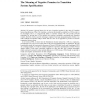490 search results - page 75 / 98 » Formal Action Semantics for a UML Action Language |
ATAL
2007
Springer
14 years 1 months ago
2007
Springer
Intelligent agents that are intended to work in dynamic environments must be able to gracefully handle unsuccessful tasks and plans. In addition, such agents should be able to mak...
LPNMR
1990
Springer
13 years 11 months ago
1990
Springer
We present a general theory for the use of negative premises in the rules of Transition System Specifications (TSSs). We formulate a criterion that should be satisfied by a TSS in ...
IJCAI
2007
13 years 9 months ago
2007
The action language Golog has been applied successfully to the control of robots, among other things. Perhaps its greatest advantage is that a user can write programs which constr...
ECOOPW
1998
Springer
13 years 12 months ago
1998
Springer
This paper explains the structure of a project repository, which enables you to trace business processes and business rules to the architecture and design of the software system. T...
INTERNET
2010
13 years 6 months ago
2010
abstractions, concepts, and actions that characterize human experiences. This will herald computing for human experience (CHE). The CHE vision is built on a suite of technologies t...

